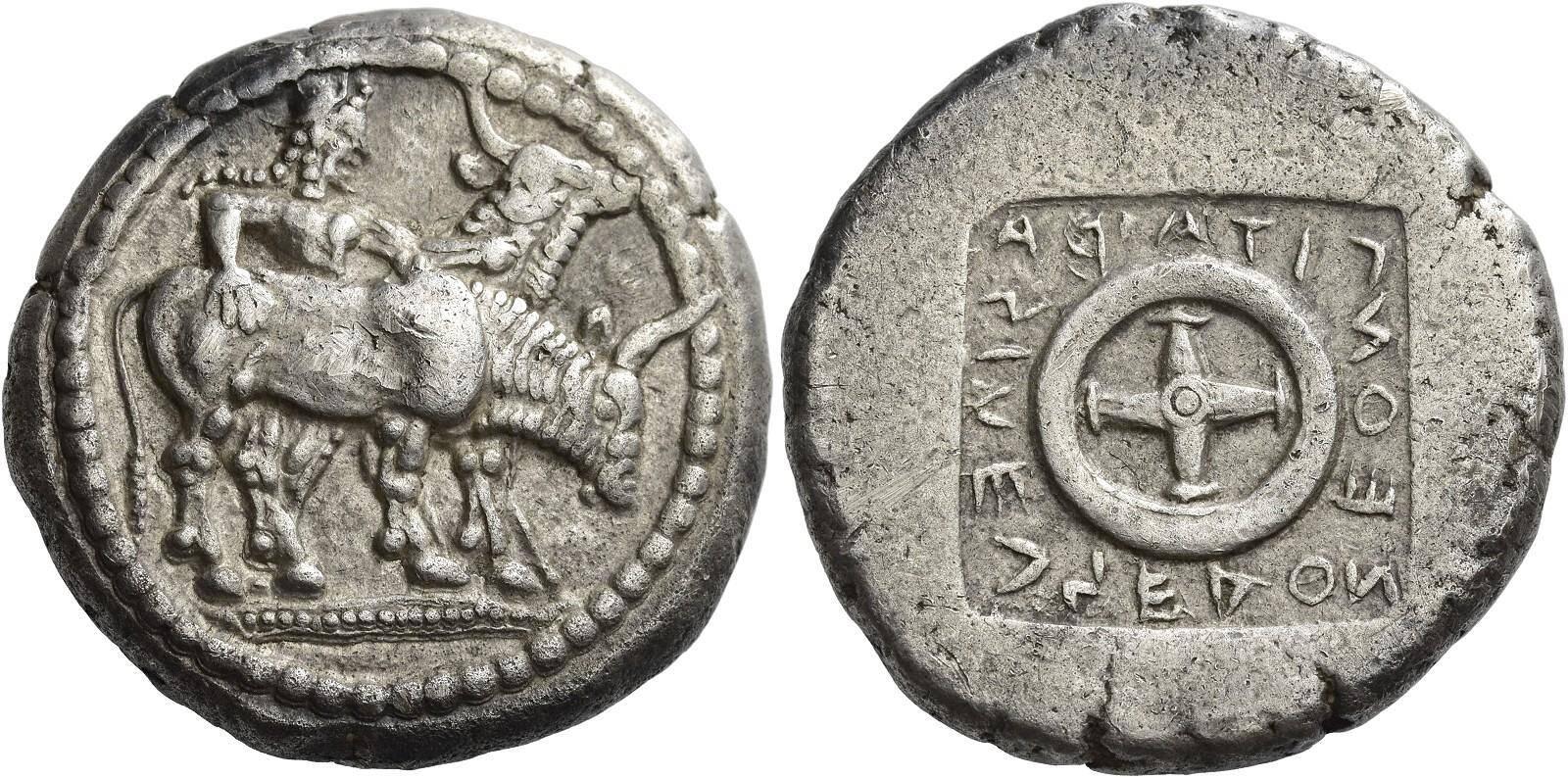S 1201 - Pangaion (uncertain mint) (Getas), silver, octodrachms (510-465 BCE) Tatscheva
From SILVER
510 BCE - 465 BCE Silver 22,249 kg
Description
| ObverseInscription or printing placed on the obverse.: | ΝΟΜΙΣΜΑ ΕΔΟΝΕΟΝ ΒΑΣΙΛΕΟΣ ΓΙΤΑ (typ I) ; ΓΕΤΑ ΒΑΣΙΛΕΩΣ ΗΔΟΝΕΩΝ (typ II) ; ΒΑΣΙΛΕΥ ΗΔΩΝΕΩΝ (typ III) (Greek).Man guiding two bulls right. Border of dots. |
| ReverseInscription or printing placed on the reverse.: | ΓΕΤΑ ΒΑΣΙΛΕΩΣ ΗΔΟΝΑΝ (or ΗΔΟΝΕΩΝ or ΗΔΟΝΕΟΝ) (Greek).Several types: 1) Wheel, 2) quadripartite incuse square. |
Mint and issuing power
| MintIdentifies the place of manufacture or issue of a numismatic object.: | Pangaion (uncertain mint) | Ancient regionAncient region.: | Macedon | Modern countryModern country: Greece | AuthorityIdentifies the issuing power. The authority can be "pretended" when the name or the portrait of X is on the coin but he/she was not the issuing power. It can also be "uncertain" when there is no mention of X on the coin but he/she was the issuing power according to the historical sources: | Getas (king of the Edones), Thraco-Macedonian tribes |
Chronology
| FromIdentifies the initial date in a range assigned in a numismatic context. | 510 BCE | toIdentifies the final date in a range assigned in a numismatic context.. | 465 BCE | PeriodTime period of the numismatic object.: Archaic until 480 BC |
Physical description
| MetalThe physical material (usually metal) from which an object is made.: | Silver |
Median weightMedian of the weights of numismatic objects (in grams). in grams | 29.00 | DenominationTerm indicating the value of a numismatic object. Examples: tetradrachm, chalkous, denarius.: | octodrachm |
StandardStandard.: | Thraco-Macedonian |
Image

S1201 Getas.jpg [1]
References
| Die study referencePublication of the study: | Tatscheva 19981Tatscheva 1998 | ||
| Coin series referenceReference to coin series study: | Sear I2Sear I, n° 1323 | ||
Obverse dies distribution
| FrequencyFrequency of specimen in distribution. ᵖ | Number of obversesNumber of obverse dies. ᵖ (o) | % (o) | Number of coinsNumber of coins. (n) | % (n) | Die nameName(s) of the die(s). |
| 1 | 7 | 77.78 | 7 | 63.64 | |
| 2 | 2 | 22.22 | 4 | 36.36 | |
| Total | 9 of 9 | 100 | 11 of 11 | 100 |
Reverse dies distribution
no distribution is available
Quantification
| Number of obversesNumber of obverse dies. ᵖ (o) | 9 | Number of singletons (o1)The number of singleton coins. ᵖ | 7 |
| Number of reverse diesNumber of reverse dies. (r) | 11 | Number of coinsNumber of coins. (n) | 11 |
| Coins per obverse dieNumber of coins per obverse die. (n/o) | 1.22 | Coins per reverse dieNumber of coins per reverse die. (n/r) | 1 |
| Reverse per obverse ratioRatio of obverse dies divided by reverse dies. (r/o) | 1.22 | Percentage of singletons (o1)number of coins (n) divided by the number of singletons (o1) ᵖ | 77.78 % |
| Original number of dies (O) (Carter 1983 formula)The estimation of the number of coins according to Carter 1983 ᵖ | 38.36 | Coins struck if 20,000 as average productivity per dieCoins made if the average productivity for obverses (according to Carter) is 20,000. ᵖ | 767,200 |
| Original number of dies (O) (Esty 2011 formula)The estimation of the number of coins according to the singleton formula in Esty 2011 ᵖ (O) | 49.5 | Survival rate if 20,000 as average productivity per dieSurvival rate if average productivity is 20,000. ᵖ | 0.00001 |
| Coverage (o = % of O) (Esty 1984 formula)Esty 1984 - coverage (% of O) ᵖ (o = % of O) | 36.36% | Die productivity if survival rate 1/2,000Average productivity if survival rate is 1/2,000. ᵖ | 573.51 |
| Weight of silver (in kg) if 20,000 coins per die (O = Carter formula)Carter 1983 * Median weight * 20000 (*10 if gold or electrum) ᵖ | 22,249 kg <br /> 22,249 kg | Die productivity if survival rate 1/5,000Average productivity if survival rate is 1/5,000. ᵖ | 1,433.79 |
Remarks
See ID 12284 (Tzamalis 2012)